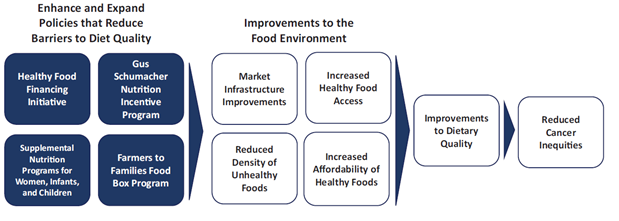Improving Availability of Healthy Food Reduces Cancer Inequities
Dietician and researcher urges policymakers to help build healthy food environments to reduce cancer cases in under-resourced areas.
The Challenge
Almost 1 out of 5 cases of cancer are related to dietary behaviors and excess body weight, especially colorectal, liver, and pancreatic cancer. And the cases of those cancers are not equally distributed through all populations.
Compared with White men, African American/Black men have a risk for developing and dying from colorectal cancer, liver cancer, pancreatic cancer, stomach cancer, and prostate cancer. People who are American Indian/Alaskan Natives or Hispanic/Latinx are at a higher risk for developing liver cancer.
Improving dietary behaviors can lead to substantial savings in healthcare costs and reduce inequities in the development of cancer in under-resourced communities.
The challenge is that minority populations who live where income is low tend to face high barriers to healthy eating. There are fewer grocery stores in such communities and more convenience stores that don’t sell as many healthy foods like fresh fruits and vegetables.
One way to start making healthy foods more accessible is through policy changes. Policy makers can support programs that improve the local food environment where it’s needed and incentivize healthy food purchases.
How Policymakers Can Improve the Food Environment and Help Reduce Cancer Inequities

This graphic from Lisa Tussing-Humphreys, PhD, article in TBM, shows how policymakers’ decisions to fund incentive plans at multiple levels can lead to improvements in the availability of food, or the food environment. It then shows how those improvements can reduce the barriers in areas where healthier foods have been harder to get and afford, which ultimately can help reduce cancer inequities based on race/ethnicity, income, and region.
The Research
American Cancer Society research grantee Lisa Tussing-Humphreys, PhD, is the senior author on a Translational Behavioral Medicine (TBM) article that urges policymakers to “Support policies that foster a healthy food environment and incentivize healthy food purchases to mitigate cancer inequities.”
It is too early to know how programs supported by the Agricultural Act of 2018 affected the long-term health of populations who have a higher risk of cancer due to their race/ethnicity, income, or the region they live in. But early outcomes have been largely positive. Over 70% of customers interviewed after the implementation of a Healthy Food Financing Initiative (HFFI) project reported buying more fruits and vegetables because it was easier to find them at the store. Consumers participating in nutrition incentive programs like The Gus Schumacher Nutrition Incentive Program (GusNIP) eat more fruits and vegetables, have greater food security, and see overall improvements in their health.”
Lisa Tussing-Humphreys, PhD
University of Illinois at Chicago College of Medicine
ACS Grantee

She and her co-authors urge policymakers to:
- Promote nationwide programs that give target populations cash incentives to buy fruits and vegetables.
Studies show that can lead to a 26% increase in consumption over 1 year.
It’s projected that such nationwide distribution could prevent almost 5,000 new cancer cases a year in the US, especially in populations affected by health inequities.
- Increase support toward Farm Bill initiatives that help fund healthier crops and incentivize improvements to the local food environment for everyone.
Funds from the Healthy Food Financing Initiative (HFFI) have introduced more than 1,000 healthy food projects in the USA, including new and improved grocery stores and restaurants in under-resourced communities.
Yet, funding is not mandatory and HFFI funded less than 10% of project applications in 2020.
- Offer farmers tax incentives and better protections to donate extra meat, dairy, fruits, and vegetables to increase food availability to under-resourced neighborhoods and reduce food waste.
As much as 31% of food is wasted in the US each year. Such incentives to farmers will divert foods away from the waste stream and into hands of people in under-resourced communities where the risk of diet-associated cancers is higher.
Why It Matters
Establishing policies that expand access to healthy food options in underserved communities is a crucial step towards health equity and cancer prevention. Strategies that reduce the population burden of cancer will also decrease healthcare costs and cancer disparities.
- Related resources
- For researchers


